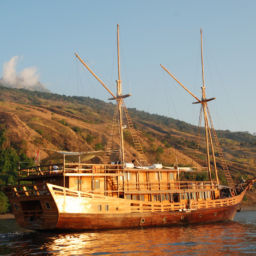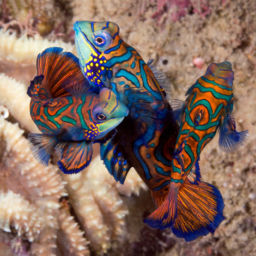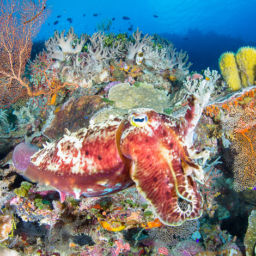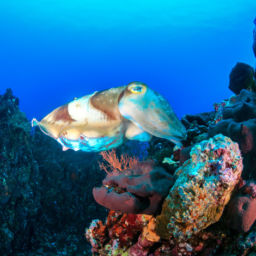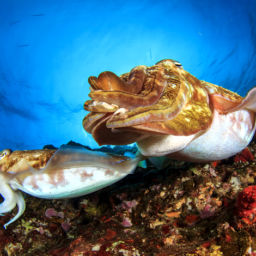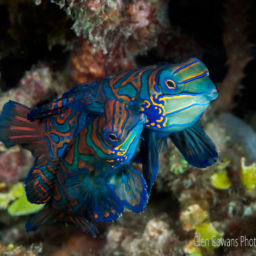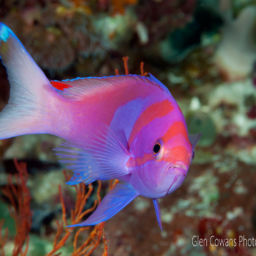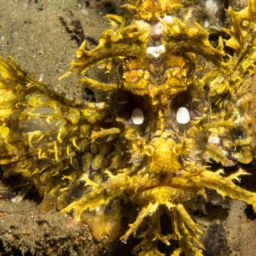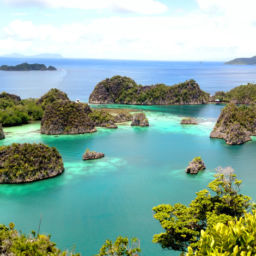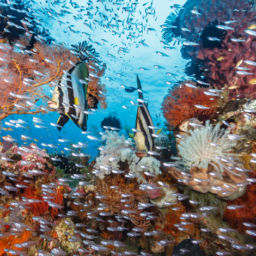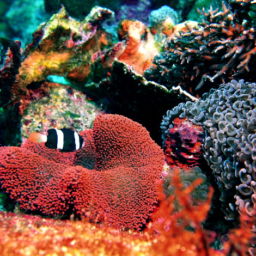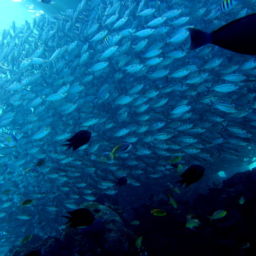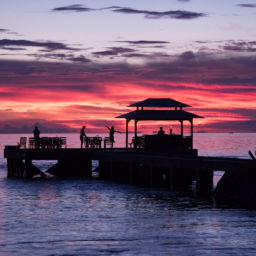When it comes to the wildlife in Komodo, two large and unusual creatures (one aquatic and one terrestrial) come to mind: giant mantas and Komodo dragons. There are dive sites in both north and south Komodo to see the former, like Manta Point in the north, and a specific spot, Rinca Island, to see the latter. Seeing both mantas and dragons is a bucket-list experience in Komodo. But diving nearly any site in Komodo offers up some spectacular underwater scenery.
Mantas

Manta Point is one of Komodo’s most famous dive sites, and the name gives away the reason. This cleaning station for oceanic and reef mantas is in open water between the islands of Rinca and Komodo. It’s not a deep spot — between 10 and 30 feet (3 – 10 meters) — with a flat or sloping sand/rocky bottom. Coral outcrops contain anemones, clownfish, turtles, and various other reef fish to entertain you while you meander around, waiting for the site’s namesake to show up. Due to the reasonable depth and lack of strong currents, snorkeling or freediving is also an option. I saw only two mantas there — one quite large and one smaller — but other divers said they saw several. There’s never any guarantee, but it’s never a waste of time to blow bubbles waiting for giant mantas.
Dragons
You can’t go to Komodo and not stop to see the famous Komodo dragons. We opted to visit Rinca Island instead of Komodo due to the higher probability of seeing them on Rinca. These massive lizards can grow to 10 feet long and weigh up to 300 pounds. Despite their generally lackadaisical attitude, Komodo dragons can be quite aggressive. They can run up to 15 miles per hour — something we actually got to see when a male wandered a bit too close to a female’s nest and she bolted out of there at a stunning speed.
You cannot explore this hot, arid island without a guide because of the dragons’ unpredictable nature, their speed, and their deadly bites. Make no mistake: these are dangerous animals who can and have killed people before. There’s some debate as to whether their bite is venomous, but it’s a nasty bite regardless. I’ll admit that the fact that the rangers who accompanied us were armed only with sticks left most of us feeling just a tad worried. The hike to the top for the view was well worth the (minor) risk and heat, though. Just be sure to bring water.
Underwater video was shot with my Paralenz camera.
The drone footage was taken by Mike Corey of Kick the Grind
Special Thanks to Indonesia Travel and my crazy dive buddy Neyu.
Secret Pinnacles
Once you’ve crossed mantas and dragons off your list, it’s time to focus on all the other diving on offer in Komodo. The pinnacles we dove were highlights of our trip, and while they weren’t really secrets, of course, they certainly felt that way. When you come upon them in the middle of nowhere — without even a surface reference for one of them — they certainly seem like undiscovered dive spots. We wondered how they were ever found to begin with.
Dives at the two standout sites, Batu Balong and Castle Rock (the one with no surface reference) require extensive briefings beforehand. Both places are well-known for unpredictable currents — both horizontal and vertical. Divers should be experienced to visit these sites, and following the guide’s rules and advice are paramount to safety. Negative entries are often necessary. Although the intense briefings led to some pre-dive anxiety, both sites were well worth it.
Batu Balong had strong currents on the surface, but not so much once you dropped down and hugged the rock wall. It’s a true pinnacle in that it’s a basically a small, vertical wall dive with currents rushing past both sides. As long as we stayed in the middle of the rock and away from the edges where the currents were, we were well shielded.
We started deep, around 90 to 100 feet (27 to 30 m). We zig-zagged our way across the backside of the rock and upward for the duration of the dive, eventually doing our safety stop in a shallow coral garden. Sharks and tuna meandered a short distance away, turtles hung on the wall munching on algae, schools of sweetlips and surgeonfish crossed between us, and a few lucky divers got to see a napoleon wrasse.
Castle Rock, while also a pinnacle, had a slightly different topography. We quickly dropped to a similar depth as Batu Balong. From there, we worked our way up a sloping wall that never broke the surface. Currents were consistent here, forcing us to kick almost constantly just to stay in place. Trevally, mackerel, batfish, and all the usual reef fish call Castle Rock home. Blacktip sharks were always just out of reach, moving around schools of barracuda. We worked our way up the slope for the duration of the dive and eventually did our safety stop by either kicking to stay in place or holding onto a rock as the currents got stronger as we got shallower.
Overall, these two pinnacles served up some of the most amazing dives I’ve ever done anywhere. All of us surfaced from both with the same word on our lips – “wow.”
Both sites offered turtles, sharks, rays, massive schools of fish, healthy coral, drop-offs, crevices, and awe-inspiring vertical views.
Extras
It’s best to do Komodo by liveaboard. If you’re diving it that way, you can check out some other highlights. Every evening at sunset, hundreds of fruit bats take to the skies and migrate from Bat Island to Rinca and Flores in search of food. It’s a fascinating spectacle and one that you don’t see in many places in the world.
Also amazing is the sunrise at Gili Laba (Lawa) Island. To see it means that you must rise at zero-dark-thirty. Then you must take a small boat to an (even more) out-of-the-way island. Next, you hike up a steep, rocky hill in the dark that will — at multiple points — make you question your decision to get out of bed at 3:30 am. But it’s worth it. Trust me. Just bring a flashlight, some water, and a camera, do your morning exercise and then enjoy the show.
In the end, Komodo knocked our socks off — or should I say booties? The giant mantas, living dragons, and awe-inspiring pinnacles left us breathless and wanting more. Like Alor, Komodo is better left to experienced divers.
But as much as Komodo impressed us, we had one destination left: the almost-mythical Raja Ampat. And it was time to see how it compared.
Featured images shot by Oliver from Fathomless Life and KOtravellers
For more on diving and travel in Indonesia, visit Wonderful Indonesia.







